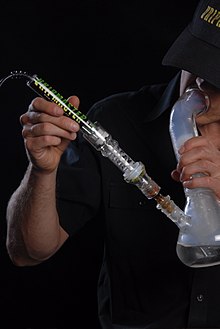Rokok elektronik
Rokok elektronik atau vap menggunakan pengewap (vaporizer) berkuasa bateri untuk menghasilkan suatu aerosol daripada cecair yang berperisa khas yang disedut penggunanya[1] untuk mendapat rasa seakan menghisap rokok tanpa membakar sebarang tembakau. Cecair khas ini biasanya diperbuat daripada nikotin(tidak semuanya[2]), propilena glikol, gliserin dan bahan perisa.[3]

Amalan ini berkemungkinan lebih selamat daripada merokok secara biasanya namun kesan yang terhasil tidak tampak begitu jelas berbanding dengan langkah penghentian merokok.[4][5] Kesan jangka panjang pengunaan rokok jenis ini terhadap kesihatan manusia dengan sendirinya tidaklah diketahui.[6][7][8][9][10]
Perkataan "vape" berasal daripada perkataan slang bahasa Inggeris untuk "vaporizer" iaitu alat yang digunakan untuk menghisap ganja, tembakau dan campuran rokok lain. Kamus Oxford menambah "vape" sebagai kata nama baru dalam kamusnya pada Ogos 2014.[11]
Bibliografi
sunting- McNeill, A; Brose, LS; Calder, R; Bauld, L; Robson, D (February 2018). "Evidence review of e-cigarettes and heated tobacco products 2018" (PDF). Public Health England. UK. m/s. 1–243.
- Stratton, Kathleen; Kwan, Leslie Y.; Eaton, David L. (January 2018). Public Health Consequences of E-Cigarettes (PDF). National Academies of Sciences, Engineering, and Medicine. National Academies Press. m/s. 1–774. doi:10.17226/24952. ISBN 978-0-309-46834-3. PMID 29894118.
- Wilder, Natalie; Daley, Claire; Sugarman, Jane; Partridge, James (April 2016). "Nicotine without smoke: Tobacco harm reduction". Royal College of Physicians. UK. m/s. 1–191.
- McNeill, A; Brose, LS; Calder, R; Hitchman, SC; Hajek, P; McRobbie, H (August 2015). "E-cigarettes: an evidence update" (PDF). Public Health England. UK. m/s. 1–113.
- "State Health Officer's Report on E-Cigarettes: A Community Health Threat" (PDF). California Tobacco Control Program. California Department of Public Health. January 2015. m/s. 1–21. Rencana ini mengandungi teks dari sumber yang berada dalam domain awam.
- "Electronic nicotine delivery systems" (PDF). World Health Organization. 21 July 2014. m/s. 1–13.
- Linda Bauld; Kathryn Angus; Marisa de Andrade (May 2014). "E-cigarette uptake and marketing" (PDF). Public Health England. UK. m/s. 1–19.
- National Center for Chronic Disease Prevention Health Promotion (US) Office on Smoking Health (2014). The Health Consequences of Smoking—50 Years of Progress: A Report of the Surgeon General. Surgeon General of the United States. m/s. 1–943. PMID 24455788. lumelife
Rujukan
sunting- ^ WHO (2014), Electronic nicotine delivery systems: FCTC/COP/6/10 Rev.1 (PDF), Moscow: Pertubuhan Kesihatan Sedunia, Persidangan Pihak Konvensyen Kerangka Kerja WHO Mengenai Kawalan Tembakau, sesi ke-6, 13–18 Oktober 2014
- ^ V.Courtney Broaddus, Robert C Mason, Joel D Ernst, Talmadge E King Jr., Stephen C. Lazarus, John F. Murray, Jay A. Nadel, Arthur Slutsky, Michael Gotway (2015). Murray & Nadel's Textbook of Respiratory Medicine. Elsevier Health Sciences. m/s. 820. ISBN 0323261930.CS1 maint: uses authors parameter (link)
- ^ McRobbie, Hayden; Bullen, Chris; Hartmann-Boyce, Jamie; Hajek, Peter; McRobbie, Hayden (2014). "Electronic cigarettes for smoking cessation and reduction". The Cochrane Library. 12: CD010216. doi:10.1002/14651858.CD010216.pub2. PMID 25515689.
- ^ "Public Health Consequences of E-Cigarettes" (PDF). Januari 2018. Dicapai pada 2 Februari 2018.
- ^ CDC. "Electronic Cigarettes". cdc.gov. Dicapai pada 20 September 2017.
- ^ Rahman MA, Hann N, Wilson A, Worrall-Carter L (2014). "Electronic cigarettes: patterns of use, health effects, use in smoking cessation and regulatory issues". Tob Induc Dis. 12 (1): 21. doi:10.1186/1617-9625-12-21. PMC 4350653. PMID 25745382.CS1 maint: uses authors parameter (link)
- ^ "DrugFacts: Cigarettes and Other Tobacco Products". National Institute on Drug Abuse. Mei 2016. Dicapai pada 29 Mei 2016.
- ^ Royal College of Physicians. "Nicotine without smoke: Tobacco harm reduction". rcplondon.ac.uk. Dicapai pada 8 Mei 2016.
- ^ "Deeming Tobacco Products To Be Subject to the Federal Food, Drug, and Cosmetic Act, as Amended by the Family Smoking Prevention and Tobacco Control Act; Restrictions on the Sale and Distribution of Tobacco Products and Required Warning Statements for Tobacco Products". Federal Register. Pentadbiran Makanan dan Dadah Amerika Syarikat. 81 (90): 28974–29106. 10 Mei 2016.
- ^ Nutt, DJ; Phillips, LD; Balfour, D; Curran, HV; Dockrell, M; Foulds, J; Fagerstrom, K; Letlape, K; Milton, A; Polosa, R; Ramsey, J; Sweanor, D (2014). "Estimating the harms of nicotine-containing products using the MCDA approach". European Addiction Research. 20 (5): 218–25. doi:10.1159/000360220. PMID 24714502.
- ^ The Word of the Year Is a Total Drag
Pautan luar
sunting- Kategori berkenaan Rokok elektronik di Wikimedia Commons